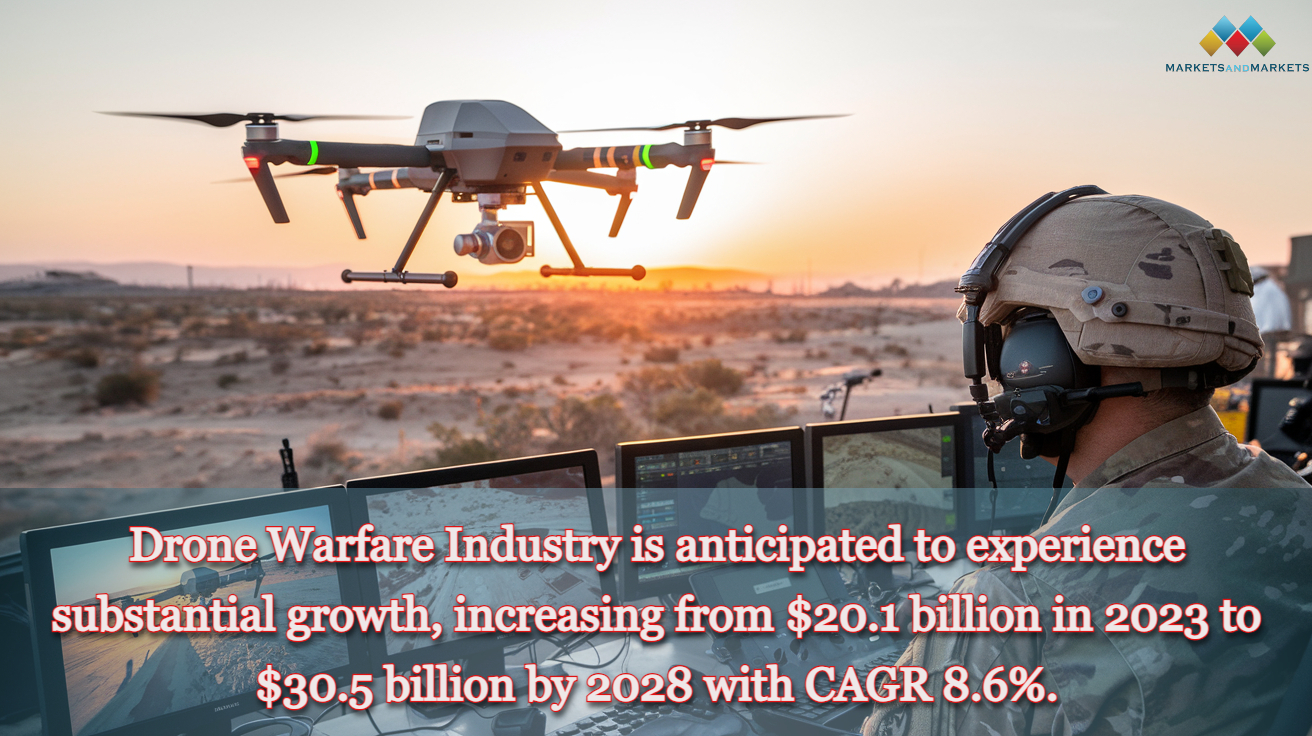The Drone Warfare Industry has rapidly evolved, becoming a critical component of modern military and defense strategies worldwide. Unmanned Aerial Vehicles (UAVs), commonly known as drones, are now extensively used for various military applications, including surveillance, reconnaissance, combat, intelligence gathering, and target acquisition. Their ability to operate remotely and autonomously has transformed traditional warfare, providing a technological edge in both offensive and defensive operations.
The Drone Warfare Market is anticipated to experience substantial growth, increasing from USD 20.1 billion in 2023 to USD 30.5 billion by 2028 with CAGR 8.6%. This growth is driven by increased investments in advanced military solutions to enhance defense forces’ capabilities. The rise in piracy and territorial encroachments in regions like Central Asia, South America, East Africa, the Indian subcontinent, Southeast Asia, and West Africa has led to heightened maritime patrolling and anti-piracy operations. As a result, there is a growing reliance on Unmanned Aerial Vehicles (UAVs) for maritime patrolling and identifying potential hotspots.
Download PDF Brochure @
https://www.marketsandmarkets.com/pdfdownloadNew.asp?id=117992027
Key Drivers of Growth
- Technological Advancements: The integration of artificial intelligence (AI), machine learning, and data analytics in drone technology has significantly enhanced the capabilities of UAVs. These innovations enable drones to perform complex missions, such as autonomous navigation, real-time data processing, and precision strikes.
- Cost-Effectiveness: Compared to traditional military assets like manned aircraft and ground forces, drones are more affordable to deploy and maintain. Their versatility allows military forces to conduct missions in challenging terrains and high-risk areas without endangering personnel.
- Global Defense Investments: Increasing defense budgets and investments in military modernization are boosting the adoption of drones. Governments and military organizations worldwide are focusing on enhancing their UAV fleets to strengthen national security and address rising global threats such as terrorism, piracy, and border conflicts.
- Versatility Beyond Warfare: While primarily used in defense, drones are also gaining traction in non-military sectors such as disaster management, environmental monitoring, border control, and humanitarian aid. Their ability to reach remote areas and provide real-time data makes them invaluable tools for a wide range of civilian applications.
Key Applications
- Surveillance and Reconnaissance: Drones offer continuous monitoring and intelligence collection in real-time, allowing military forces to track enemy movements, assess terrain, and gather critical information with minimal risk.
- Combat and Strike Missions: Armed UAVs are capable of carrying out precision airstrikes, neutralizing targets with minimal collateral damage, and engaging in combat scenarios where human pilots may not be suitable.
- Logistics and Supply Delivery: Drones can deliver critical supplies, including ammunition and medical aid, to troops in inaccessible or hostile environments, reducing logistical challenges during military operations.
Challenges and Concerns
Despite its advantages, the drone warfare industry faces several challenges:
- Ethical and Legal Issues: The use of armed drones in warfare raises ethical concerns regarding autonomous decision-making in lethal operations and the potential for civilian casualties.
- Regulatory Hurdles: Varying regulations governing UAV use across countries can hinder the deployment and growth of military drones, especially in international conflicts.
Top Leading companies driving innovation and market growth in the drone warfare industry include:
- Northrop Grumman Corporation (US)
- Raytheon Technologies Corporation (US)
- General Atomics Aeronautical Systems (GA-ASI) (US)
- Israel Aerospace Industries Ltd. (Israel)
- Teledyne FLIR LLC (US)
Ask for Sample Report @
https://www.marketsandmarkets.com/requestsampleNew.asp?id=117992027
Future Outlook
The future of the drone warfare industry looks promising, with continued advancements in AI, autonomous systems, and next-gen sensor technologies. As defense forces seek to modernize their military capabilities, the demand for drones will continue to rise. Additionally, with their expanding role in non-combat applications, drones will remain at the forefront of technological innovation and strategic military planning.

